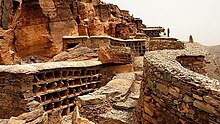
Casablanca is the largest city in Morocco and the country's economic and business centre. Located on the Atlantic coast of the Chaouia plain in the central-western part of Morocco, the city has a population of about 3.71 million in the urban area, and over 4.27 million in Greater Casablanca, making it the most populous city in the Maghreb region, and the eighth-largest in the Arab world.

Morocco, officially the Kingdom of Morocco, is a country in the Maghreb region of North Africa. It overlooks the Mediterranean Sea to the north and the Atlantic Ocean to the west, and has land borders with Algeria to the east, and the disputed territory of Western Sahara to the south. Morocco also claims the Spanish exclaves of Ceuta, Melilla and Peñón de Vélez de la Gomera, and several small Spanish-controlled islands off its coast. It has a population of roughly 37 million, the official and predominant religion is Islam, and the official languages are Arabic and Berber; French and the Moroccan dialect of Arabic are also widely spoken. Moroccan identity and culture is a mix of Arab, Berber, African and European cultures. Its capital is Rabat, while its largest city is Casablanca.
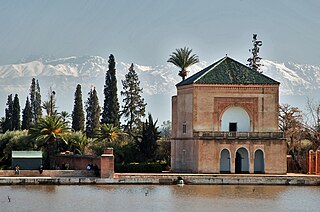
Marrakesh or Marrakech is the fourth-largest city in Morocco. It is one of the four imperial cities of Morocco and is the capital of the Marrakesh–Safi region. The city lies west of the foothills of the Atlas Mountains.
Moroccan music varies greatly between geographic regions and social groups. It is influenced by musical styles including Arab, Berber, Andalusi, Mediterranean, Saharan, West African, and others.
Maghrebi Arabic is a vernacular Arabic dialect continuum spoken in the Maghreb. It includes the Moroccan, Algerian, Tunisian, Libyan, Hassaniya and Saharan Arabic dialects. It is known as ad-Dārija. This serves to differentiate the spoken vernacular from Literary Arabic. Maghrebi Arabic has a predominantly Semitic and Arabic vocabulary, although it contains a few Berber loanwords which represent 2–3% of the vocabulary of Libyan Arabic, 8–9% of Algerian and Tunisian Arabic, and 10–15% of Moroccan Arabic. Maghrebi Arabic was formerly spoken in Al-Andalus and Sicily until the 17th and 13th centuries, respectively, in the extinct forms of Andalusi Arabic and Siculo-Arabic. The Maltese language is believed to have its source in a language spoken in Muslim Sicily that ultimately originates from Tunisia, as it contains some typical Maghrebi Arabic areal characteristics.

Moroccan architecture reflects Morocco's diverse geography and long history, marked by successive waves of settlers through both migration and military conquest. This architectural heritage includes ancient Roman sites, historic Islamic architecture, local vernacular architecture, 20th-century French colonial architecture, and modern architecture.

The Museum of Marrakech is a historic palace and museum located in the old center of Marrakesh, Morocco. In addition to its notable architecture, the museum's collection showcases various historic art objects and contemporary art from Morocco.
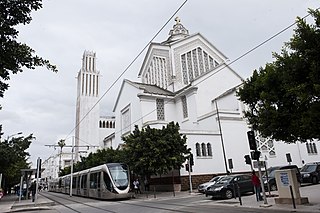
The Catholic Church in Morocco is part of the worldwide Catholic Church, under the spiritual leadership of the Pope in Rome. Catholics account less than 40% of the overall population of over 31 million. The country is divided into two archdioceses; Rabat and Tangier.
Moroccan literature are the written and oral works of Moroccan culture. These works have been produced and shared by people who lived in Morocco and the historical states that have existed partially or entirely within the geographical area of modern-day Morocco. Apart from the various forms of oral literature, the written literature of Morocco encompasses various genres, including poetry, prose, theater, and nonfiction including philosphical and religious literature. Moroccan literature has mainly been written in Arabic and French, and to a lesser extent also in Berber languages, Judeo-Arabic, Spanish, and after the mid-19th century in English.[pages needed] Through translations into English and other languages, Moroccan literature has become accessible to readers worldwide.

Moroccans are the citizens and nationals of the Kingdom of Morocco. The country's population is predominantly composed of Arabs and Berbers (Amazigh). The term also applies more broadly to any people who are of Moroccan nationality, sharing a common culture and identity, as well as those who natively speak Moroccan Arabic or other languages of Morocco.

The history of the cinema of Morocco dates back to "The Moroccan Goatherd" by Louis Lumière in 1897. During the French protectorate, films were produced and directed by French filmmakers, and in 1952, Orson Welles directed his Othello in the historic city of Essaouira. Since independence in 1956, Moroccan film directors developed the national film industry. Emergence in the 1970s met with growing international success.
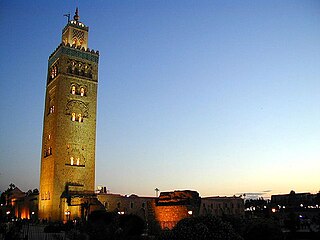
This article describes notable landmarks and architecture in the city of Marrakesh, Morocco.

There are a number of languages in Morocco. De jure, the two official languages are Standard Arabic and Standard Moroccan Berber. Moroccan Arabic is by far the primary spoken vernacular and lingua franca, whereas Berber languages serve as vernaculars for significant portions of the country. The languages of prestige in Morocco are Arabic in its Classical and Modern Standard Forms and sometimes French, the latter of which serves as a second language for approximately 33% of Moroccans. According to a 2000–2002 survey done by Moha Ennaji, author of Multilingualism, Cultural Identity, and Education in Morocco, "there is a general agreement that Standard Arabic, Moroccan Arabic, and Berber are the national languages." Ennaji also concluded "This survey confirms the idea that multilingualism in Morocco is a vivid sociolinguistic phenomenon, which is favored by many people."

Arab-Berbers are a population of the Maghreb, a vast region of North Africa in the western part of the Arab world along the Mediterranean Sea and the Atlantic Ocean. Arab-Berbers are people of mixed Arab and Berber origin, most of whom speak a variant of Maghrebi Arabic as their native language, some also speak various Berber languages. Many Arab-Berbers identify primarily as Arab and secondarily as Berber.
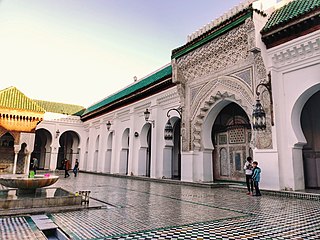
Fez or Fes is a city in northern inland Morocco and the capital of the Fès-Meknès administrative region. It is the second largest city in Morocco, with a population of 1.11 million, according to the 2014 census. Located to the northwest of the Atlas Mountains, it is surrounded by hills and the old city is centered around the Fez River flowing from west to east. Fez has been called the "Mecca of the West" and the "Athens of Africa". It is also considered the spiritual and cultural capital of Morocco.
The following is a timeline of the history of the city of Meknes, Morocco.
The Yves Saint Laurent Museum in Marrakech is a museum dedicated to the fashion designer Yves Saint Laurent located in Marrakesh, Morocco.
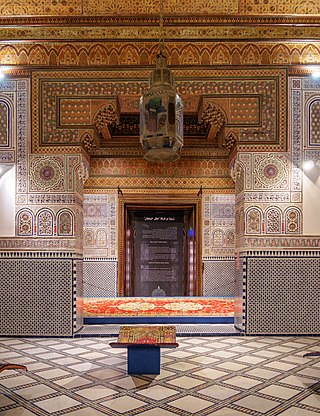
Dar Si Said is a historic late 19th-century palace and present-day museum in Marrakesh, Morocco.

Jewelleryof the Berber cultures is a historical style of traditional jewellery that was worn by women mainly in rural areas of the Maghreb region in North Africa and inhabited by indigenous Berber people. Following long social and cultural traditions, Berber or other silversmiths in Morocco, Algeria and neighbouring countries created intricate jewellery with distinct regional variations. In many towns and cities, there were Jewish silversmiths, who produced both jewellery in specific Berber styles as well as in other styles, adapting to changing techniques and artistic innovations.
Jean Besancenot,, born as Jean Girard, was a French painter, documentary photographer, and self-trained ethnographer, active mainly during the 1930s and 1940s in the French protectorate in Morocco.

















